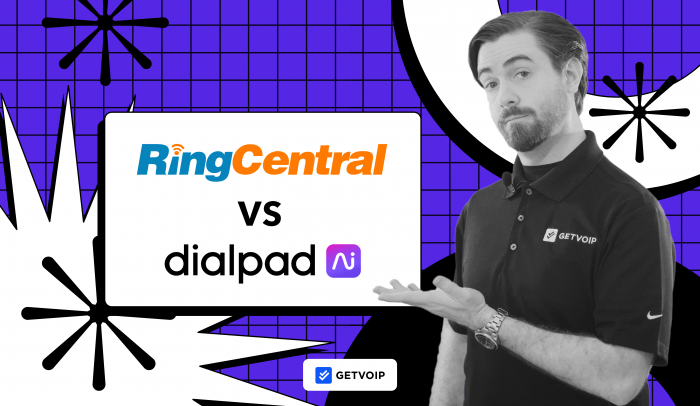Summary: RingCentral and Dialpad both offer unified communications across voice, SMS, video calling, and team chat. Both provide scalable, tier-based pricing and extensive add-ons that allow users to access omnichannel contact center capabilities, AI-powered sales tools, speech and text analytics, and agent performance coaching features.
RingCentral provides better internal team collaboration tools, offering AI-enhanced video calls for up to 200 participants, webinar and online event packages, and GenAI-powered chat messaging. Dialpad offers stronger real-time and conversational analytics, AI-powered call summaries, and business text messaging.
Teams with extensive third-party integration needs should opt for RingCentral, while businesses requiring priority customer support should choose Dialpad. Both platforms offer some of the best built-in voice calling features in the UCaaS space, though Dialpad is the better fit for teams with more complex call routing needs and a high inbound daily call volume.
How We Compared RingCentral and Dialpad
We used the below criteria to compare RingCentral vs Dialpad:
- Pricing, Plans, and Upgrades: We evaluated each provider’s pricing, plans, value, add-ons, and upgrades
- Voice Calling: We compared essential voice calling features like IVR, call queues, call recording, and call routing
- Business Text Messaging: We reviewed available SMS/MMS texting features and limitations
- Video Meetings: We compared video conferencing participant capacities, maximum lengths, and in-meeting features
- Team Collaboration: We evaluated team chat tools, file sharing/storage capabilities, whiteboards, and other collaboration features
- Analytics: We reviewed real-time and historical analytics, AI-powered reporting tools, and custom KPIs
- Third-Party Integrations: We compared available third-party integrations and APIs
- Security and Support: We evaluated customer support availability and channels, support add-ons, network reliability, and security standards
RingCentral vs Dialpad: At A Glance
| RingCentral RingEX | Dialpad Business Communications | |
| Best For |
|
|
| Pricing+Plans |
|
|
| Add-Ons+Upgrades |
|
|
| Voice Calling |
|
|
| Business Texting |
|
|
| Video Meetings |
|
|
| Team Collaboration |
|
|
| Analytics |
|
|
| Third-Party Integrations |
|
|
| Network Security+Reliability |
|
|
| Customer Support |
|
|
RingCentral vs Dialpad: Pricing, Plans, and Add-ons
Summary: With plans starting from $15/user/month, Dialpad is slightly more affordable than RingCentral, which offers plans from $20/user/month. Because Dialpad’s Enterprise plan is quote-based, it’s difficult to estimate its value–but the RingCentral RingEX Ultra plan is transparently priced from $35/user/month.
Unlike RingCentral, each Dialpad plan has a seat minimum requirement, which could drive up costs for small businesses needing the 100-seat minimum Enterprise plan. While Dialpad offers better business text messaging rates than RingCentral, all Dialpad users must purchase toll-free numbers for $15-$17/month and pay $0.02/toll-free minute.
RingCentral Pricing and Add-Ons
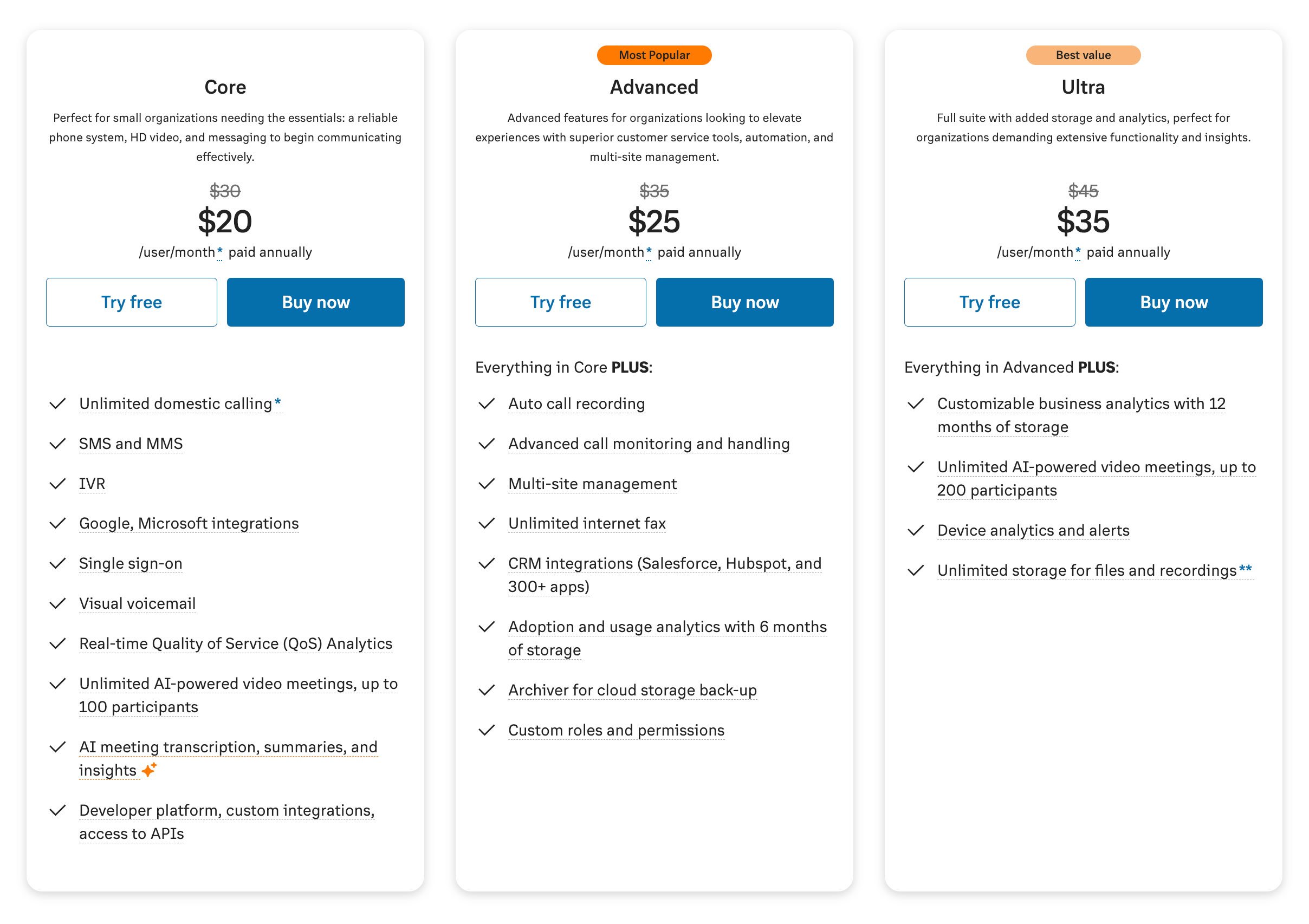
All RingEX plans include basic video calling, but users can upgrade to RingCentral Webinar for $30-$54/organizer/month to access YouTube livestreaming, social sharing/tracking, AI-powered webinar content creation, practice rooms, real-time translations, and more.
RingEX users can add on the RingSense AI Sales Intelligence suite for $60/user/month which includes conversation intelligence, AI-powered coaching and deal scoring or the RingCentral CX Contact Center from $65/agent/month which includes workforce engagement tools, outbound dialers, and conversational analytics.
Dialpad Pricing and Add-Ons
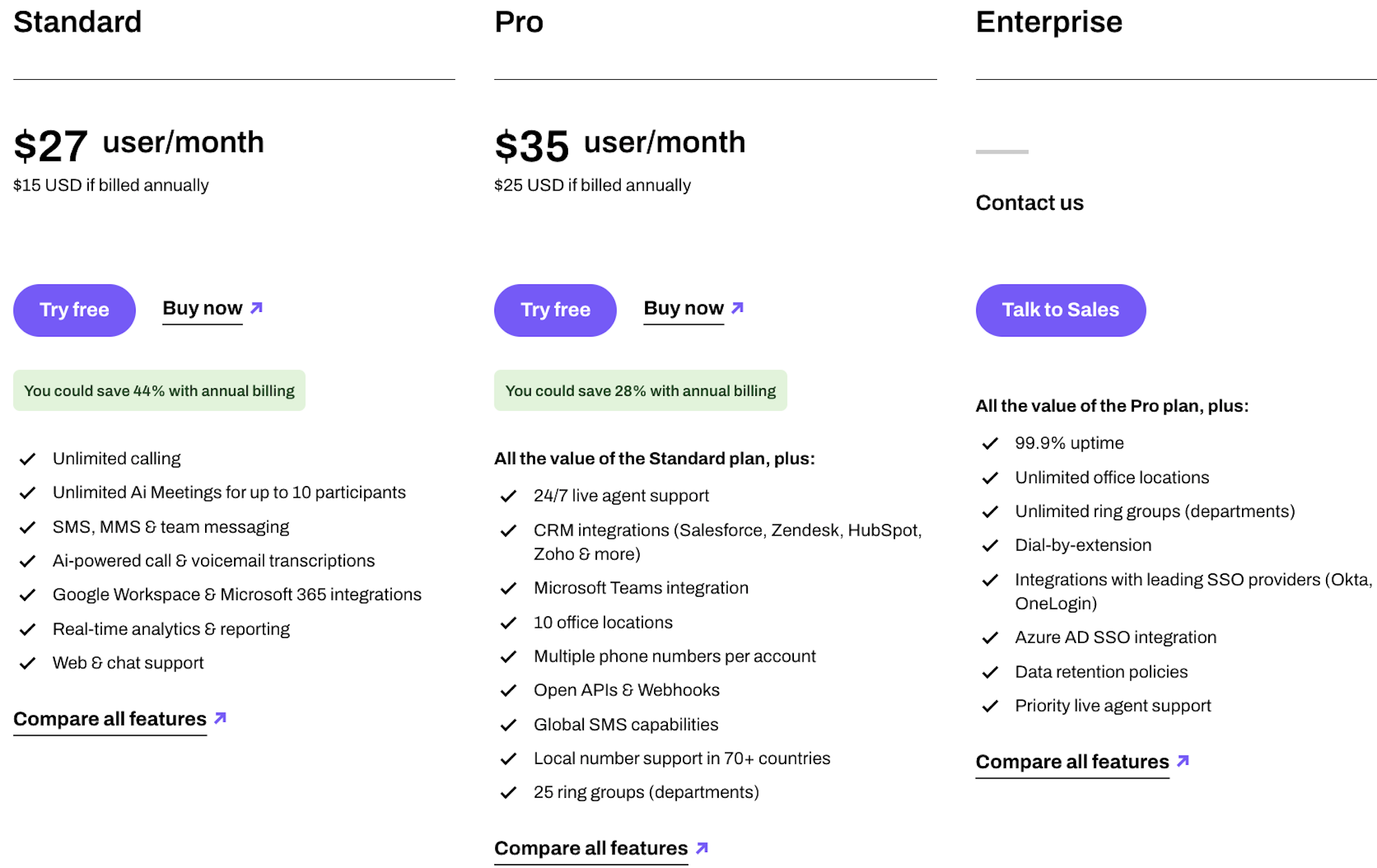
The Dialpad Support platform has three plans from $80-$150/user/month and includes real-time call monitoring and coaching, omnichannel voice and digital communication channels, AI Agent Assist, agent performance scoring, and CSAT monitoring.
Dialpad Sell ranges from $60-$150/user/month and includes access to outbound auto dialers, advanced in-call coaching and performance monitoring tools, CSAT scores, AI Agent Assist, and platinum support.
RingCentral vs Dialpad: Voice Calling
Summary: RingCentral and Dialpad both include advanced VoIP phone system features like visual voicemail, multi-level IVR, call recording, and unlimited domestic calling on all plans. While all Dialpad plans include more AI-powered calling features than RingCentral, they lack the toll-free calling, real-time call monitoring/whisper, and built-in virtual faxing RingCentral provides. Both platforms limit skills-based call routing and outbound auto dialers to Contact Center plans.

Dialpad Business Communications and RingCentral RingEX both offer impressive voice calling features across all plans, including customer self-service via IVR, call forwarding, answering rules, call flip, and voicemail transcription. The biggest differences between Dialpad and RingCentral are toll-free calling, call routing, ring groups and call queues, AI-powered calling capabilities, and call monitoring.
Dialpad requires all users–even Enterprise plan holders–to purchase toll-free numbers as paid add-ons from $15-$17/number/month plus $0.02/toll-free minute. All RingCentral plans include a toll-free number and, depending on the specific plan, between 100-10,000 monthly toll-free minutes.
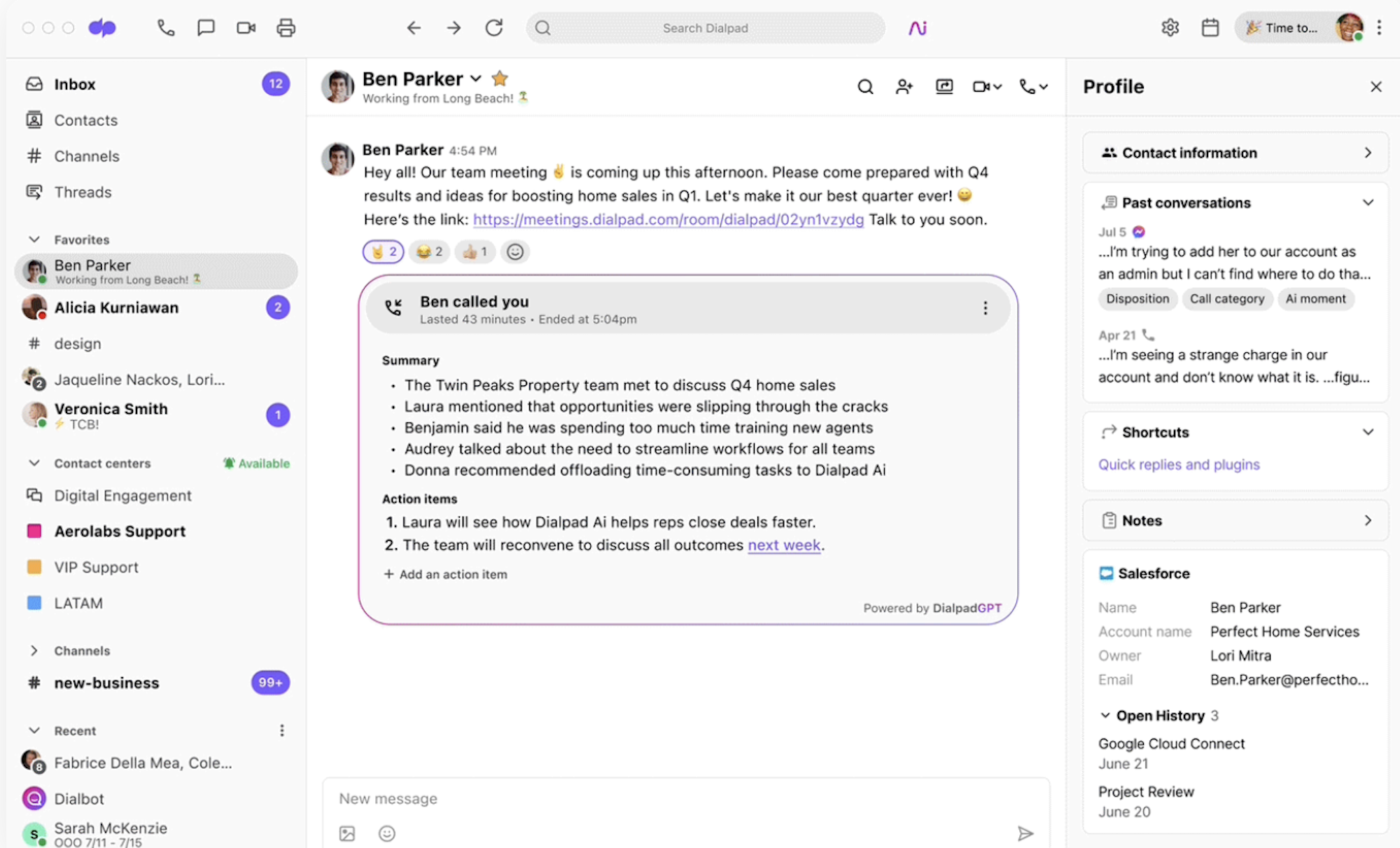
That said, all Dialpad plans include custom call routing, on-demand and automatic call recording, personal working hours, AI call summaries, and real-time call transcription. While RingCentral also provides AI call summaries, automated call notes, suggested action items, automatic call recording, and call routing, these capabilities are limited to more expensive RingEX plans.
RingCentral vs Dialpad: Business Text Messaging
Summary: Dialpad offers better domestic SMS/MMS messaging than RingCentral, but unlike Dialpad, RingCentral provides mass text message marketing–a feature still in beta for Dialpad users.

All Dialpad plans include unlimited inbound SMS/MMS in the US/Canada plus 250 outbound messages/month. Additional text messages are charged at $0.008/message. RingCentral offers tier-based SMS allotments from 25-200 messages/month per user, with additional texts charged from $0.0085/message. Dialpad business texting features include the ability to favorite, search, mark as unread, and forward text messages, whereas RingCentral doesn’t appear to have any advanced SMS features.
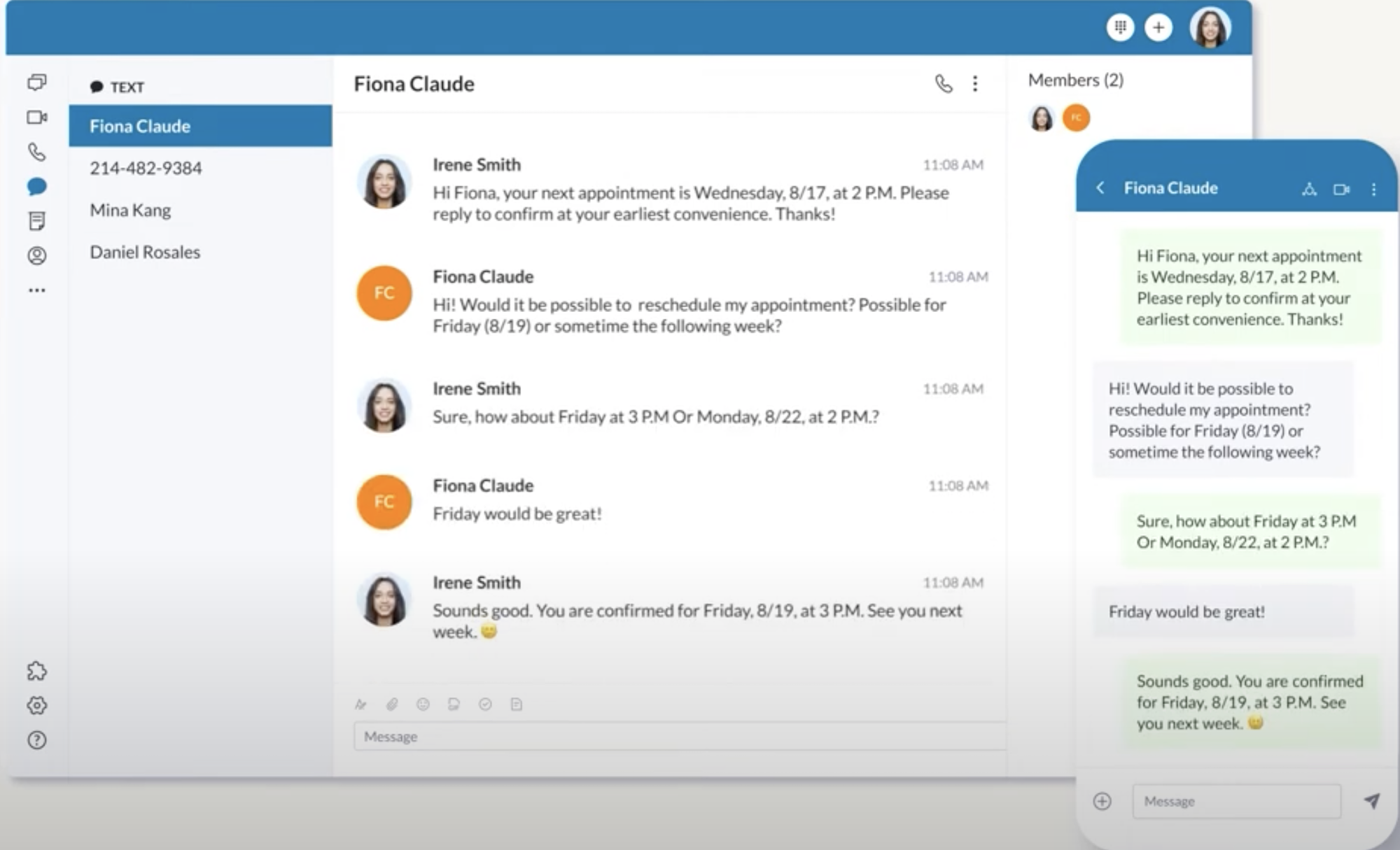
Dialpad has a slightly longer SMS character limit than RingCentral and lets up to 24 Dialpad users join a group text thread (RingCentral limits group texting to 10 users.) That said, RingCentral offers message broadcasting for up to 100 recipients plus bulk texting capabilities with pricing from $0.01/message.
Dialpad and RingCentral both provide desktop/mobile text messaging plus international SMS at per-country rates, though neither provider offers short codes.
RingCentral vs Dialpad: Video Meetings
Summary: RingCentral has far better video conferencing than Dialpad, with higher meeting participant maximums, longer meeting lengths, live meeting transcriptions, AI-powered meeting summaries, and more advanced in-meeting collaboration tools.
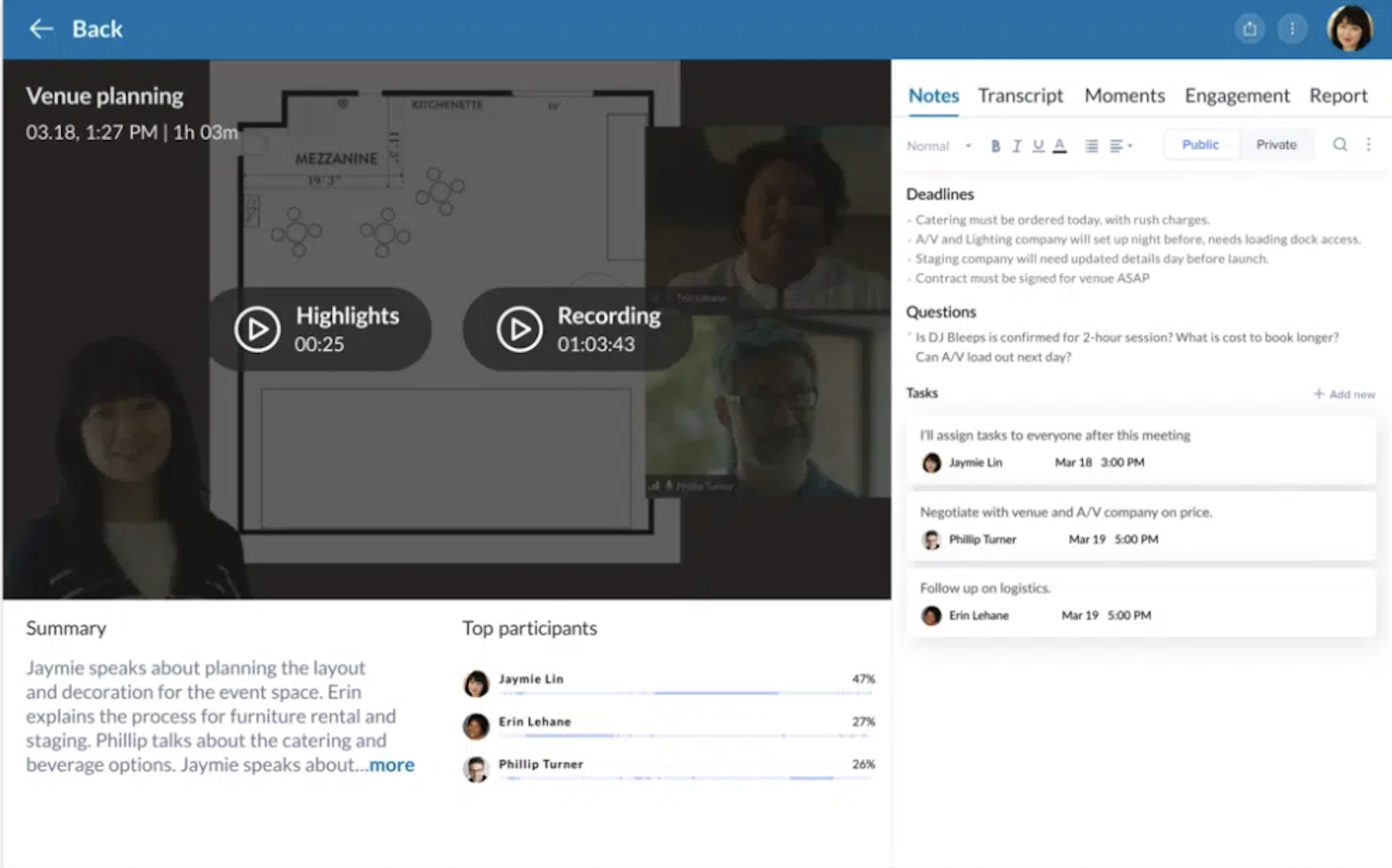
All RingCentral and Dialpad plans include on-demand and scheduled video conferencing with in-meeting chat, desktop and mobile screen sharing, waiting rooms, and virtual backgrounds. However, all RingCentral plans also include AI-powered Meeting Insights like meeting summaries, highlight reels, topic and keyword lists, collaborative meeting notes, and live and post-meeting transcriptions while Dialpad does not offer these features. RingCentral also includes video meeting recording on all plans. While Dialpad does offer unlimited meeting audio recordings, video and screen recordings require a custom plan.
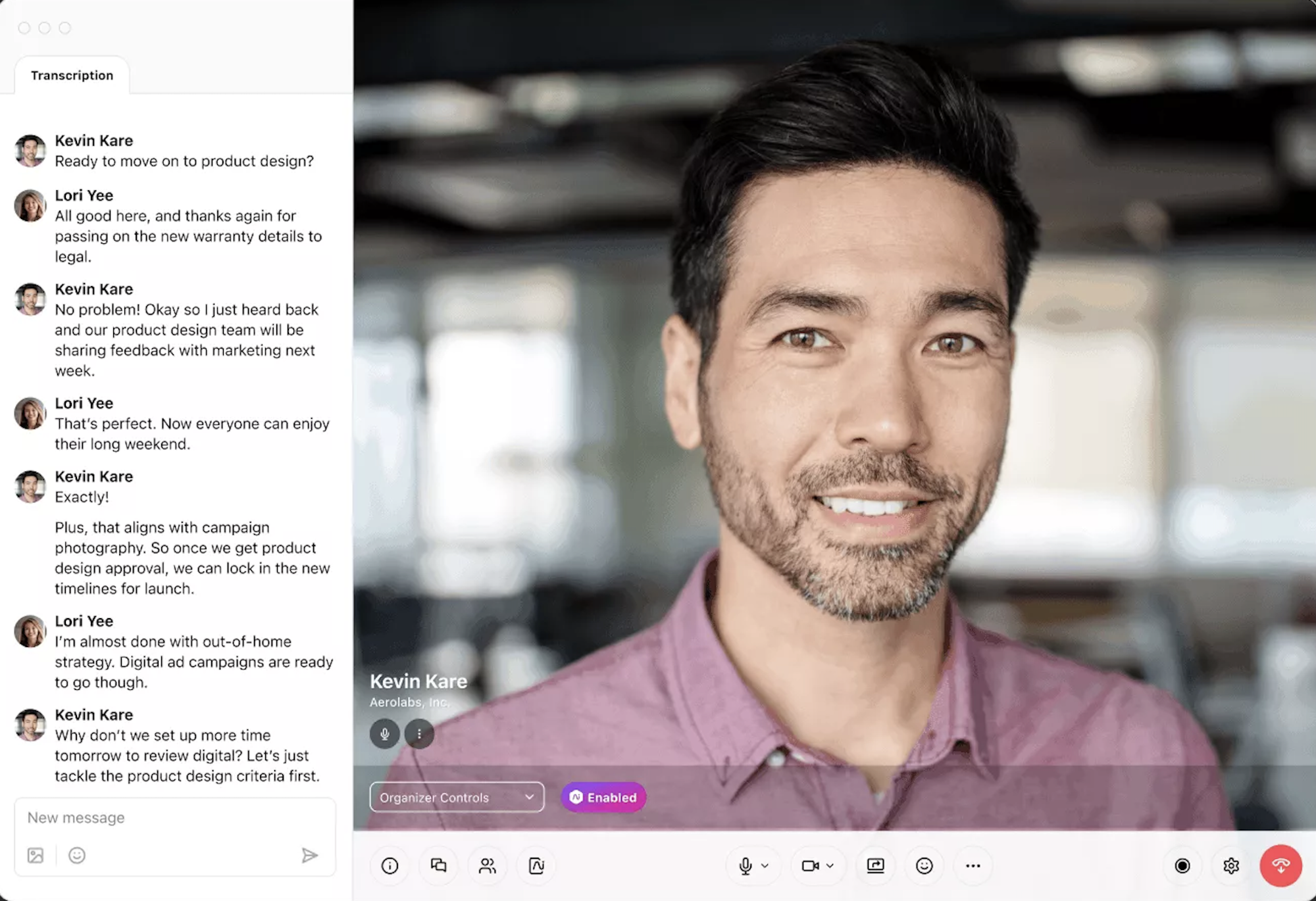
RingCentral also provides far more scalable video calling solutions than Dialpad. RingEX users can upgrade to RingCentral’s Webinar or Online Events platforms and purchase RingCentral conference room hardware. Although Dialpad has some neat features, including an automated meeting countdown timer and meeting co-hosts, no webinar or online event platforms are available.
RingCentral vs. Dialpad: AI-Powered Features
Summary: Both RingCentral and Dialpad offer powerful AI tools like Agent Assist, automated transcription and summaries, and note taking, but RingCentral includes more AI features with its business communications platform while Dialpad only includes advanced AI features as add-ons to the Dialpad Support platform.
Dialpad's AI-powered features are limited in the Dialpad Connect platform but it does include real-time call transcriptions, analytics, and reporting. Dialpad Support includes AI moments in all plans and offers AI live coach cards (Agent Assist), virtual agents and AI scorecards on some plans.
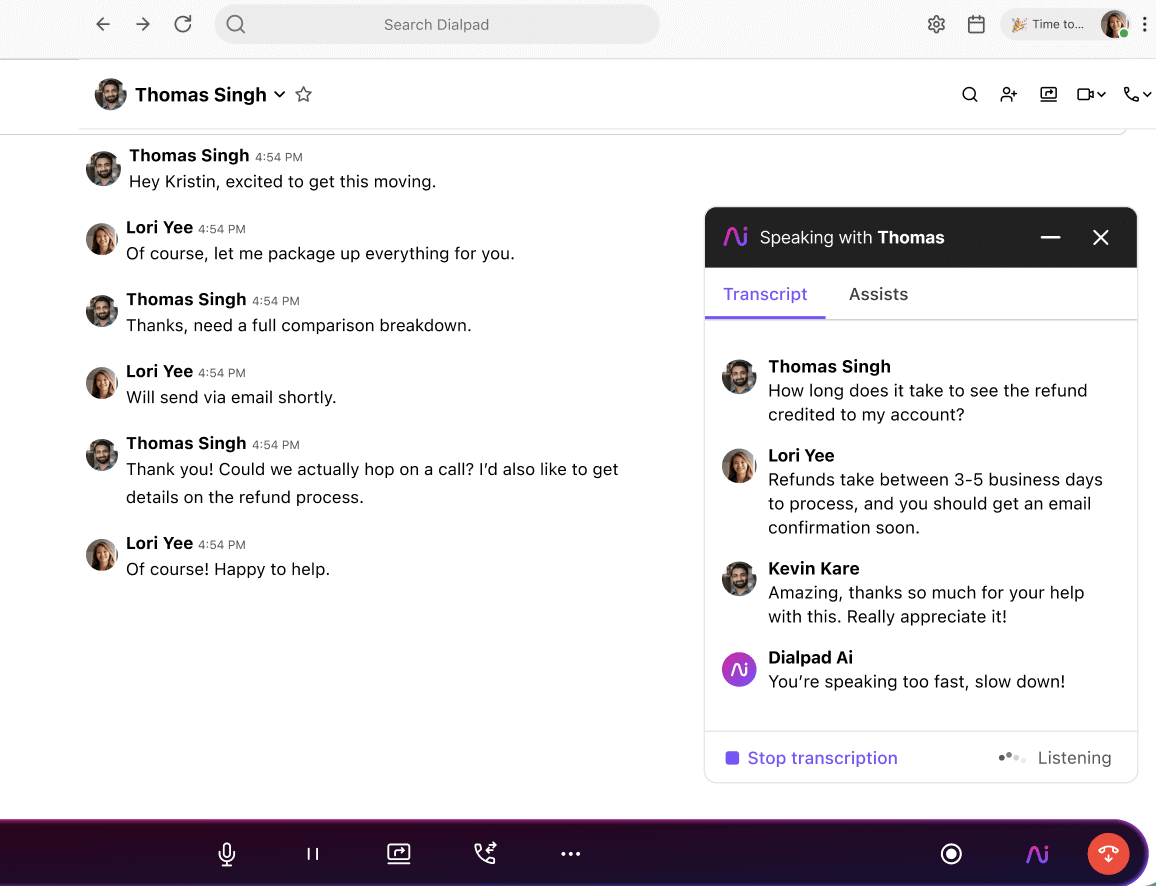
RingCentral includes an AI assistant that can generate call transcriptions and captions, take notes, automate summaries, and create content for SMS and messaging depending on the plan. An Ai-powered receptioninst that can deliver natural, seamless interactions 24/7 is available as an add-on to any plan. RingCX (RingCentral CCaaS platform) includes even more AI features such as IVA, Agent Assist, Supervisor Assist, etc.

RingCentral vs Dialpad: Team Collaboration
Summary: With AI-powered message generation and recaps, extensive team chat and file sharing capabilities, and collaborative notes included in all plans, RingCentral provides stronger team collaboration features than Dialpad. Although Dialpad includes public/private team chat, file sharing, and always-on audio chat rooms, most users will need to integrate Slack or Google Workspace to access collaboration tools comparable to RingCentral’s.
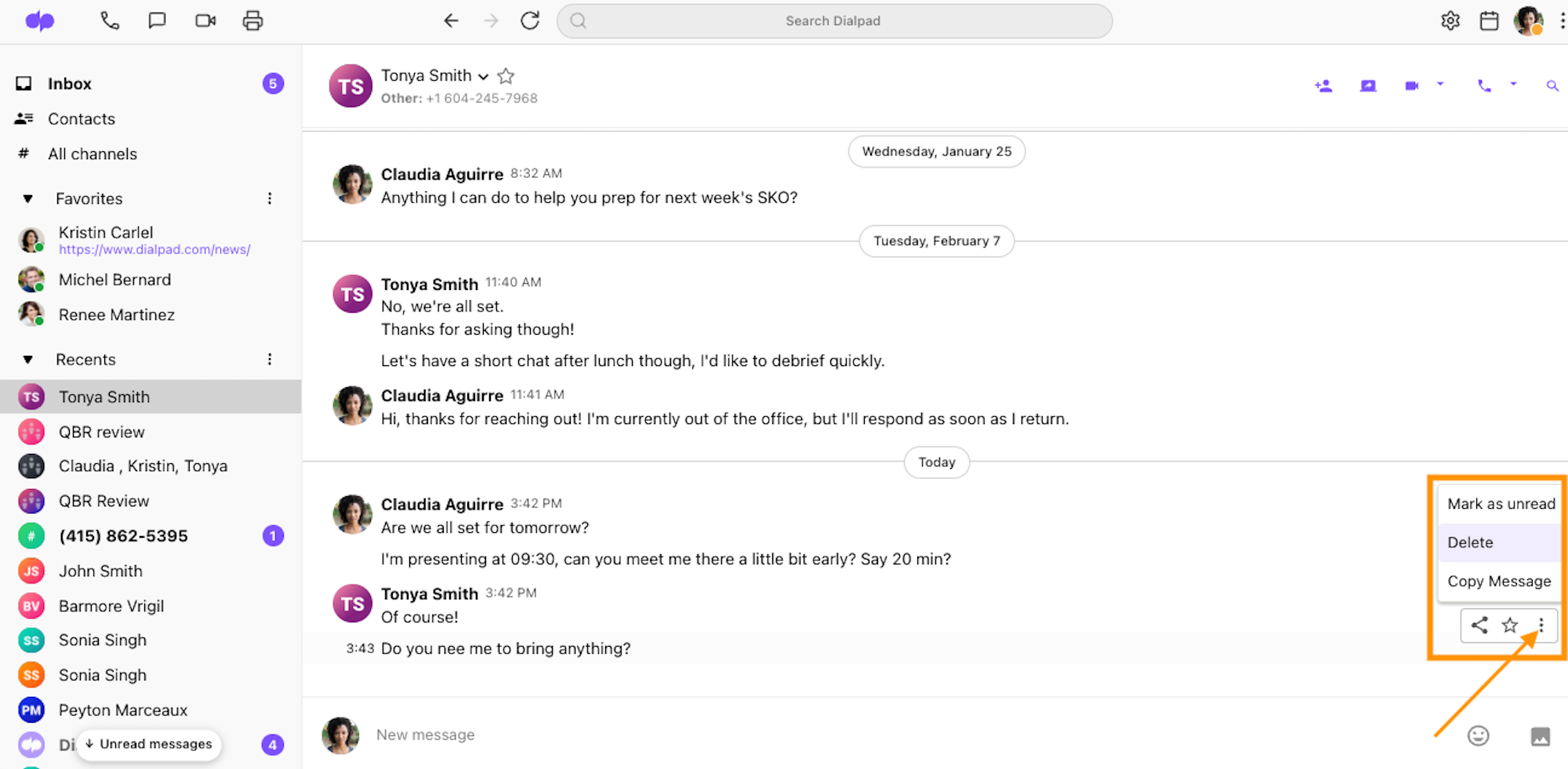
Dialpad includes basic team collaboration features in all plans, but restricts its more advanced collaboration tools, including the impressive Miro whiteboard integration, to video calls only.
Outside of video meetings, Dialpad users can create public/private team chat channels with user presence monitoring, message threading, file sharing, user tagging, and one-click voice and video calling. Dialpad’s only real standout collaboration feature is its always-on audio-only meeting room, which lets channel members “drop in” for impromptu meetings throughout the day.
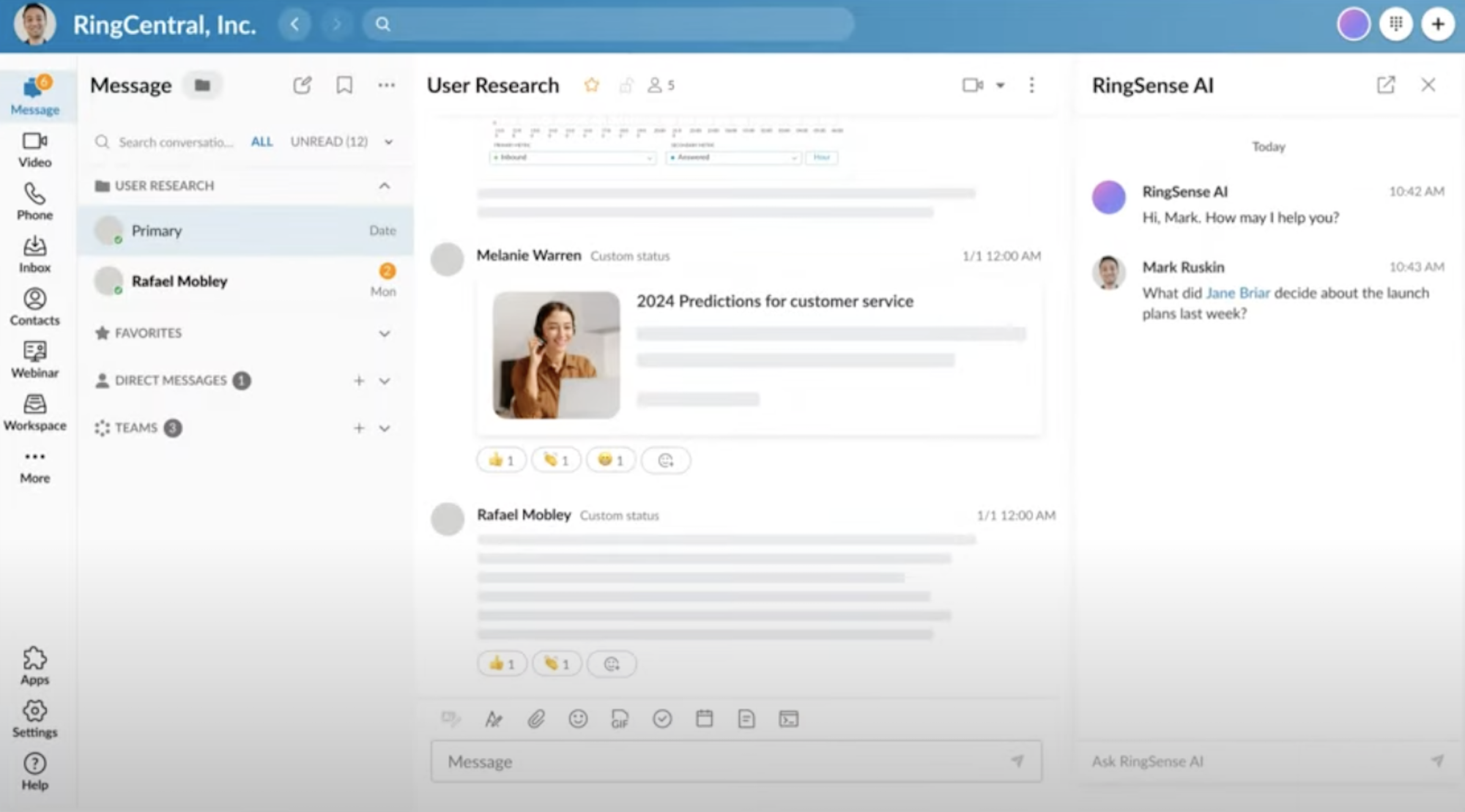
RingCentral, on the other hand, includes extensive collaboration features like team chat, file and calendar sharing, task management, and out-of-the-box integration with cloud storage applications for real-time file co-editing and versioning.
Most impressive are RingCentral’s AI-powered messaging features, available to all RingEX users. Team members can review an AI-generated message recap to avoid scrolling through missed messages to find relevant details, use AI grammar check and translation messaging tools, and even leverage GenAI to write and adjust message tone/length.
RingCentral vs Dialpad: Analytics
Summary: While both RingCentral and Dialpad offer advanced AI-powered speech and text analytics and performance coaching via paid add-ons, Dialpad Business Communications has better built-in analytics than RingEX.
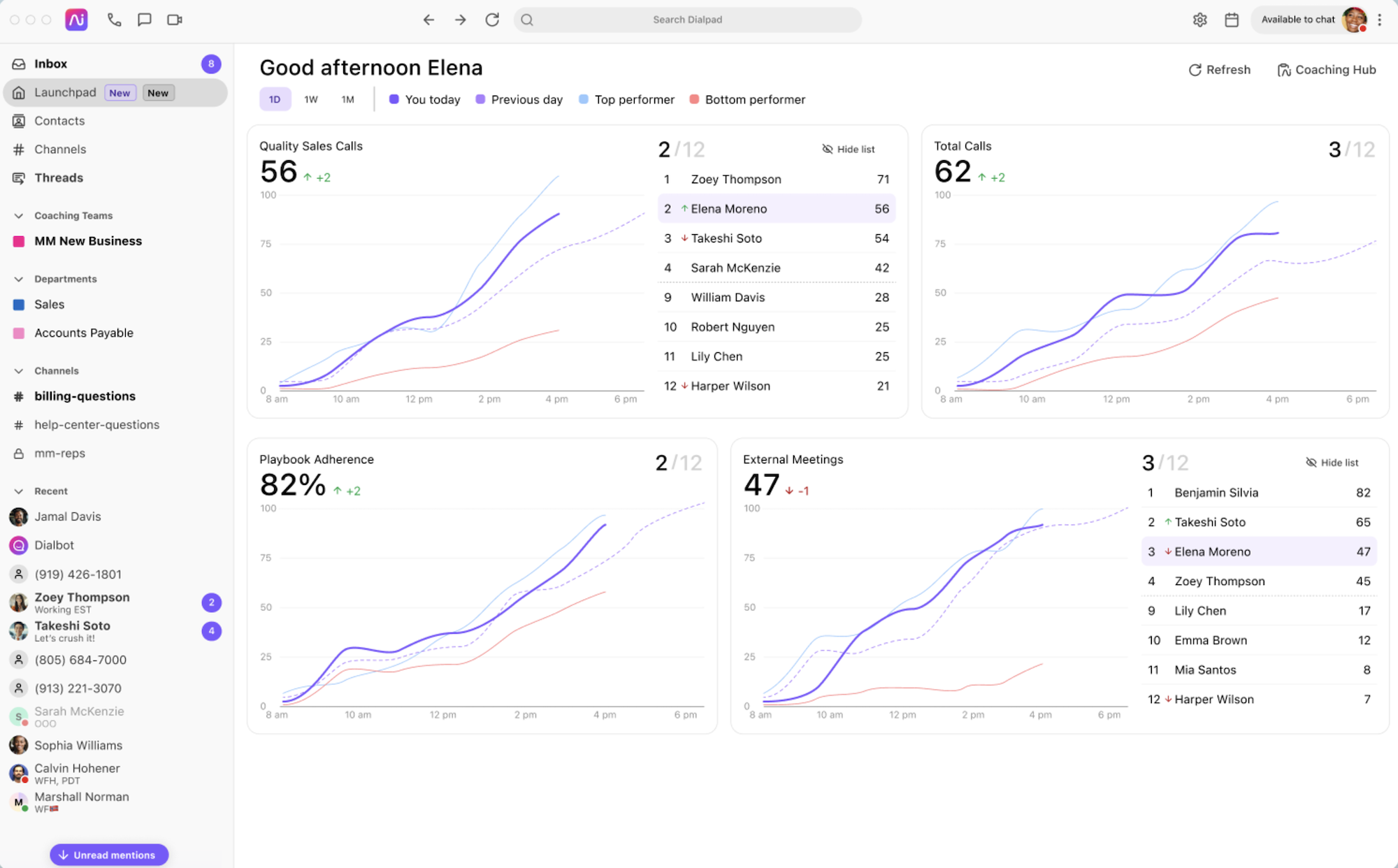
Dialpad includes live call volume monitoring, call transcription, call logs, and user presence monitoring in all plans. Higher-tier Dialpad plans include QoS monitoring and customizable historical reports, which let admins monitor call center KPIs like AHT, call queue lengths, average talk time, missed call ratios, call abandonment rates, and more.
By contrast, RingCentral offers limited real-time call center analytics and requires all RingEX users to purchase live call queue monitoring as a paid add-on.
The Dialpad Ai Sales add-on gives users access to live and AI-powered in-call coaching, agent performance scorecards, CSAT reporting, and extensive quality management tools.

The RingSense for Sales AI add-on is similar to Dialpad’s, but provides more advanced conversational analytics in addition to real-time and post-call agent coaching. RingSense for Sales includes predictive analytics, deal scoring, trending topic reports, agent leaderboards, and more. Conversational analytics like these are available only with Dialpad’s Ai Contact Center solution.
RingCentral vs Dialpad: Third-Party Integrations
Summary: RingCentral offers 200+ third party integrations and API access on all plans, while Dialpad only integrates with about ten third-party tools.
All RingEX plans integrate with Google Workspace, Microsoft 365, Slack, Microsoft Teams telephony, and offer complete API access. Advanced and Ultra plans give users access to 200+ industry-specific, CRM, helpdesk, and marketing tools like Salesforce, Zendesk, Smarsh, HubSpot, and Canvas.
Dialpad, on the other hand, has some of the most limited integration capabilities in the UCaaS space. API access is restricted to Pro and Enterprise users, and the Standard plan only integrates with Google Workspace. Pro and Enterprise users can access integrations to Slack, Zendesk, Zapier, HubSpot, Microsoft Teams, ServiceNow, OneLogin, Azure, and Okta–but that is the extent of Dialpad’s integration capabilities.
RingCentral vs Dialpad: Security, Reliability, and Customer Support
Summary:RingCentral offers more customer support channels and slightly higher reliability. Both RingCentral and Dialpad are highly secure platforms
Security
- Both platforms offer HIPAA and GDPR compliance
- Both platforms offer SSO and end-to-end encrypted voice and video calls
- All Dialpad plans include an admin portal, custom permissions, and meeting room locks
- RingEX restricts custom permissions and multi-site administration to Advanced and Ultra plans
Reliability
- All RingCentral plans come with a 99.999% uptime SLA
- Dialpad only offers a 99.9% SLA uptime to Enterprise users
Customer Support
- RingCentral and Dialpad both offer 24/7 support to all users
- RingCentral provides 24/7 live support via chat and phone on all plans
- Both providers offer premium support add-ons and custom onboarding
- Dialpad Enterprise plans include priority routing and a customer success manager
- RingCentral restricts priority routing and a customer success manager to premium support plans
RingCentral vs Dialpad: Which Provider Should You Choose?
When choosing between RingCentral and Dialpad, the right platform for your team depends on your budget, industry, business size, integration needs, and how you want to leverage AI. Below, we’ve outlined the ideal user base for RingCentral and Dialpad, as well as the potential drawbacks associated with each provider.
RingCentral Is Best For
- AI-Powered Unified Communications: RingCentral leverages AI to optimize internal communication and collaboration, reduce human error, and automate routine business processes.
- Scalable Video Conferencing: All RingCentral plans include advanced video calling capabilities like collaborative notes, screen and file sharing, whiteboards, AI-powered meeting insights, breakout rooms, etc. for up to 1,000 participants.
- Third-Party Integrations: RingCentral includes basic integrations and API access on all RingEX plans, and integrates with over 200 industry-specific CRM, helpdesk, collaboration, marketing, and analytics platforms.
RingCentral Is Not Right For
- Affordable Unified Communications: Although RingCentral RingEX is a feature-rich platform, it is much more expensive than Dialpad and other competitors in the UCaaS space.
- Real-Time Analytics: While RingCentral provides basic call logs and live QoS monitoring to all users, advanced real-time reports for call queue management require the RingSense for Sales add-on–which sets users back an additional $60/month.
- SMS Texting: While all RingCentral plans include SMS/MMS texting capabilities, users are limited to a maximum of 200 messages per month. Although RingCentral does offer high-volume SMS texting, it is still in beta and has limited capabilities.
Dialpad Is Best For
- Feature-Rich Voice Calling: All Dialpad plans include advanced call routing, call recording, live call transcription, multi-level IVR, ring groups, exec-assistant pairing, and AI-powered call summaries with suggested action items.
- AI-Powered Reporting: All Dialpad plans include live call volume analytics, user presence monitoring, call logs, and real-time call transcription.
- Global Teams: Dialpad offers unlimited calling not only in the United States and Canada, but also in the account holder’s country. Local phone number support is available in 70+ countries.
Dialpad Is Not Right For
- Video Conferencing: Video meeting recordings, automated post-meeting summaries, live meeting transcriptions, and meeting co-hosts are restricted to the Dialpad Ai Meetings Business Plan and require an additional monthly fee.
- Third-Party Integrations: Dialpad integrates with only about 10 third-party platforms, instantly ruling it out as an option for businesses with a large tech stack and extensive integration needs.
- Toll-Free Calling: Toll-free calling and toll-free business phone numbers are not included with any Dialpad Business Communications plan.
RingCentral and Dialpad Alternatives
If neither RingCentral nor Dialpad feel like the right fit for your business, there are plenty of alternative unified communications providers to explore. Popular RingCentral alternatives include 8x8, which provides better international calling than RingCentral, and Nextiva, which includes voice and digital communication channels. Top Dialpad alternatives include Zoom, which provides much stronger video conferencing capabilities than Dialpad, and Vonage, a far more scalable and customizable solution.

